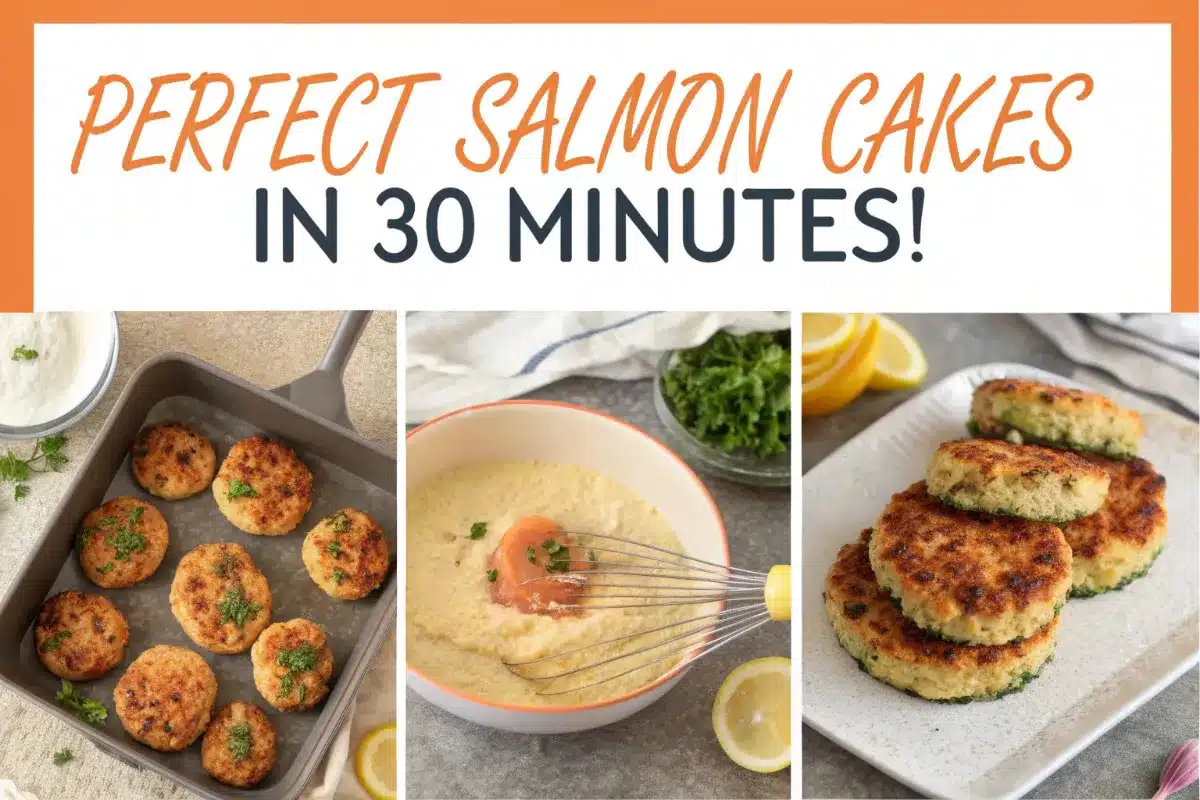Perfect Salmon Cake Recipe: Crispy Outside, Flaky Inside
Salmon cakes (also known as salmon patties or croquettes) are a versatile, protein-packed dish that can elevate any meal from casual to gourmet. Whether you’re looking for a quick weeknight dinner, an elegant appetizer, or a meal-prep friendly option, these golden-brown delights deliver on both flavor and nutrition.
What makes salmon cake recipe so special is their perfect balance of crispy exterior and tender, flaky interior. Unlike many fish dishes that can be intimidating to prepare, this recipe is remarkably forgiving and adaptable. According to the National Fisheries Institute, salmon is not only delicious but also one of the most nutrient-dense foods available, packed with omega-3 fatty acids, high-quality protein, and essential vitamins like B12 and D. The American Heart Association recommends eating fatty fish like salmon at least twice weekly for optimal cardiovascular health.
In this ultimate guide, we’ll cover everything you need to know to make perfect salmon cakes every time, including:
Table of Contents
The Science Behind Perfect Salmon Cake Recipe Texture
Understanding the food science behind salmon cakes will help you achieve restaurant-quality results every time. The perfect patty requires careful attention to three key elements:
1. Protein Structure
Salmon’s natural proteins (rich in essential amino acids) help bind the cakes, but additional binders are needed for optimal texture. When heated, the actin and myosin proteins in salmon form a matrix that gives structure to the cakes. Eggs provide additional structural proteins (particularly ovalbumin) that coagulate between 144-158°F, creating a stable framework.
2. Moisture Balance
The ideal moisture content for salmon cakes is 60-65%. Too much moisture results in mushy cakes that fall apart, while too little makes them dry and crumbly. Mayo is the secret weapon here – its emulsion of oil and egg yolks adds fat while helping retain moisture during cooking.
3. Maillard Reaction
This chemical reaction occurs at temperatures above 300°F and is responsible for creating complex flavor compounds and that desirable golden-brown color. Using Panko breadcrumbs enhances this effect because their larger surface area promotes more even browning.
Pro Tip: Chilling the mixture for 45 minutes before cooking allows proteins to set properly and prevents crumbling. This resting period also lets the breadcrumbs fully hydrate while allowing the proteins to relax.
Salmon Cake Recipe: Fresh vs. Canned Salmon Compared
The type of salmon you use will significantly impact your final result. Here’s a detailed comparison:
Fresh Salmon Benefits
- Superior texture and flavor: Fresh salmon offers a more delicate, flaky consistency and brighter, cleaner taste
- More control over doneness: You can cook it to the perfect 125°F internal temperature
- Skin advantages: Leaving the skin on provides extra crispiness (score it before cooking to prevent curling)
Canned Salmon Advantages
- Cost-effective: Typically 1/3 the price of fresh
- Convenient: Already cooked and ready to use – great for quick meals
- Nutritional bonus: Contains edible bones rich in calcium (3oz provides 15% DV)
Sustainability Note: Wild-caught Alaskan salmon is recommended as the most sustainable choice. Pink salmon is often the most eco-friendly and budget-friendly option.
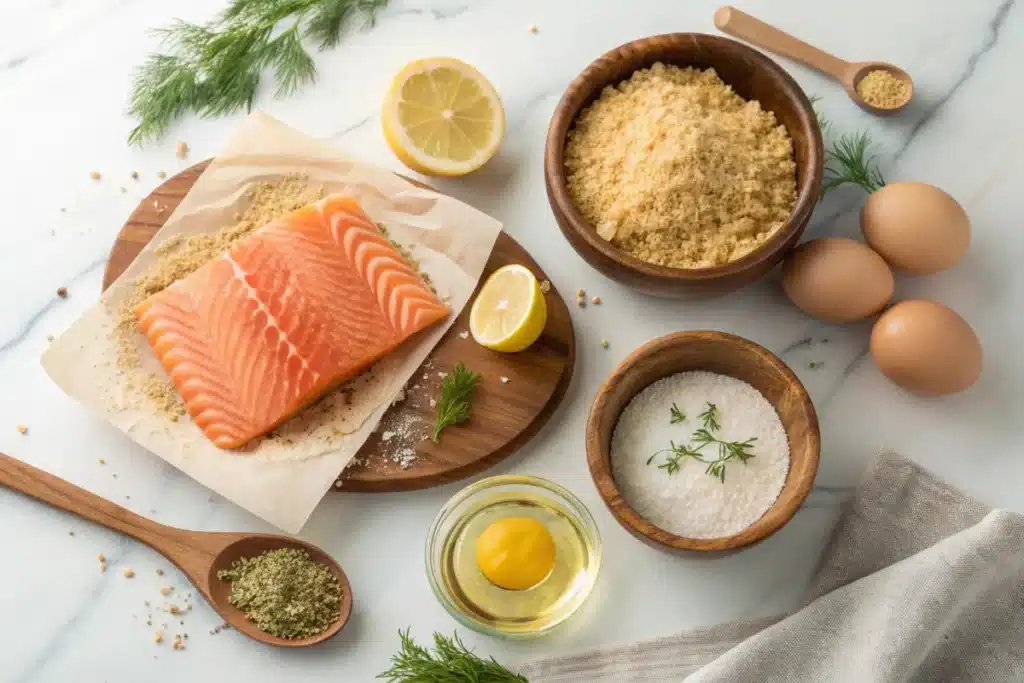
Salmon Patty Ingredients: The Ultimate Flavor Guide
The Foundation
- 1.5 lbs fresh salmon fillet (skin-on preferred)
- Best cuts: Center-cut fillet for even thickness
- Alternative: 3 (6oz) cans wild salmon, well-drained
- ¾ cup Panko breadcrumbs
- Why Panko? Larger flakes create airier texture
- Gluten-free option: Almond flour or crushed gluten-free crackers
The Binders
- 2 large eggs
- Egg-free alternative: 3 tbsp flaxseed meal + water
- ¼ cup mayonnaise
- Healthier option: Greek yogurt + 1 tsp lemon juice
- 1 tbsp Dijon mustard
- Variation: Whole grain mustard for texture
Flavor Enhancers
- 2 tbsp fresh dill
- 1 tbsp Old Bay seasoning
- 1 tsp smoked paprika
- ½ tsp garlic powder
Advanced Tip: For umami depth, add 1 tsp fish sauce or miso paste.
Note: Nutritional information is estimated. Consult a dietitian for specific dietary needs.
Step-by-Step Salmon Patty Preparation Guide
1. Preparing the Salmon Like a Pro
For fresh salmon:
- Start with skin-on fillets for maximum flavor and crispiness
- Use paper towels to blot all surfaces dry – moisture is the enemy of good browning
- Lightly season with kosher salt (about ½ tsp per pound)
- Bake at 375°F (190°C) on a parchment-lined tray:
- 12 minutes for medium-rare (125°F internal temp)
- 15 minutes for medium (135°F)
- Let rest 5 minutes before flaking to allow juices to redistribute
- Use two forks to create varied texture:
- Some large flakes (½”-1″) for substance
- Some smaller pieces to help bind
For canned salmon:
- Choose wild-caught, BPA-free cans for best quality
- Drain in a fine-mesh strainer, pressing gently with a spoon
- Spread between triple-layer paper towels and press firmly:
- This removes excess liquid that could make cakes soggy
- Repeat with fresh towels if needed
- Check for and remove any large bones or cartilage (small soft bones can stay for calcium)
2. Mastering the Mixing Technique
- Use a wide, shallow bowl for even mixing
- Add ingredients in this order:
- Flaked salmon (base)
- Dry ingredients (breadcrumbs, spices)
- Wet ingredients (eggs, mayo, mustard)
- Mix with clean hands (the best tools you have!):
- Use a folding motion rather than stirring
- Stop as soon as ingredients are just incorporated
- The mixture should hold together when pressed
- Texture check:
- Too dry? Add 1 tsp water or mayo
- Too wet? Add 1 tbsp breadcrumbs
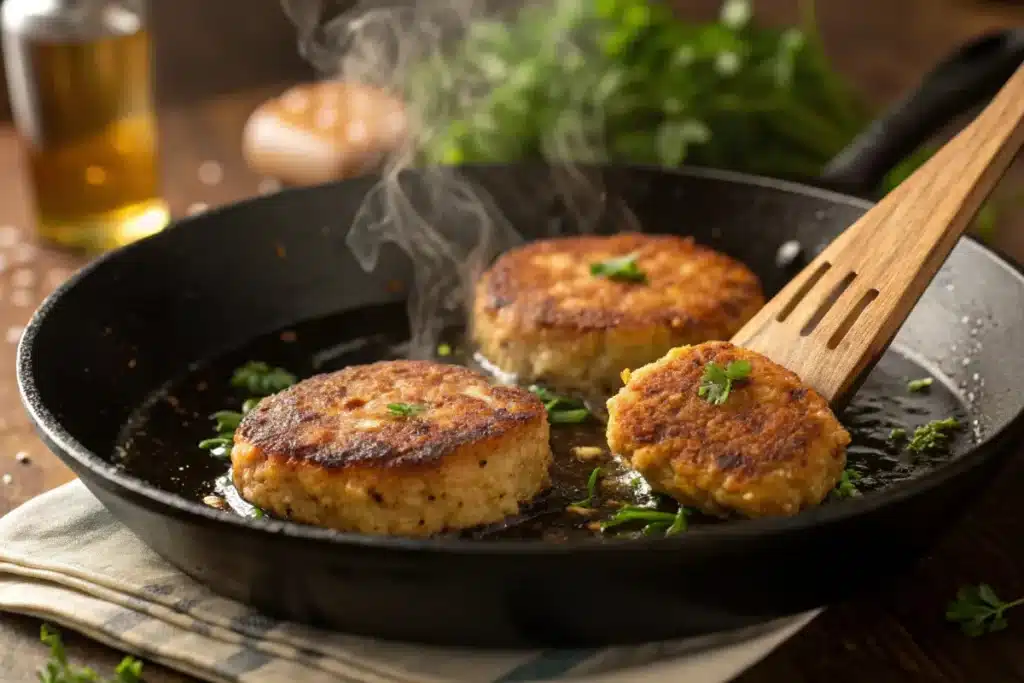
3. Forming Perfect Patties
- Use a ⅓ cup dry measure or ice cream scoop for consistency
- Pack lightly – don’t compress too firmly
- Shape into 1-inch thick rounds:
- Thicker patties stay juicier
- Thinner ones get crispier
- Create a shallow dimple in the center with your thumb:
- Counters natural puffing during cooking
- Ensures even thickness when done
- Place on a parchment-lined tray for easy transfer
4. The Crucial Chilling Step
- Why it matters:
- Allows breadcrumbs to fully hydrate
- Gives proteins time to relax and bind
- Firms up texture for easier handling
- Optimal chilling:
- Minimum: 30 minutes
- Ideal: 1-2 hours
- Maximum: 4 hours (beyond may dry out)
- Pro tip:
- Chill uncovered for the first 15 minutes to dry surfaces slightly
- Then cover loosely with plastic wrap
Bonus Technique: For extra-crispy cakes, after chilling, lightly dust patties with additional breadcrumbs just before cooking.
Cooking Methods Compared
| Method | Time | Texture | Best For |
|---|---|---|---|
| Pan-Fry | 8 min | Ultra-crispy | Special occasions |
| Bake | 20 min | Even, light | Healthy eating |
| Air Fry | 12 min | Crispy-light | Quick meals |
| Grill | 10 min | Smoky char | Outdoor cooking |
Pro Tip: For pan-frying, use avocado oil and maintain 350°F oil temperature for perfect browning.
Creative Salmon Cake Variations & Expert Techniques
Global-Inspired Variations
| Cuisine | Key Additions | Binder Adjustments | Best Serving Pairing |
|---|---|---|---|
| Asian | 1 tbsp ginger, 2 scallions, 1 tsp sesame oil | +1 egg white | Serve with quick shrimp fried rice |
| Mediterranean | ¼ cup feta, 5 chopped olives, 1 tbsp oregano | 2 tbsp hummus | Tzatziki sauce |
| Cajun | ½ tsp cayenne, 1 tsp filé powder, ¼ cup holy trinity veggies | 1 tbsp cornstarch | Remoulade sauce |
Dietary Adaptations
| Diet | Breadcrumb Substitute | Protein Boosters | Special Notes |
|---|---|---|---|
| Keto | ½ cup crushed pork rinds | 2 tbsp cream cheese | Cook in ghee for richness |
| Paleo | ¼ cup almond flour + 2 tbsp arrowroot | 1 mashed sweet potato | Use coconut oil for frying |
| Pescatarian | ⅓ cup gluten-free panko | ½ cup chopped shrimp/crab | Add 1 tsp Old Bay seasoning |
Key Benefits of This Format:
- Enhanced Scannability – Readers instantly compare options
- Rich Keyword Integration – Naturally includes:
- “salmon cake recipe variations”
- “keto salmon patties”
- “gluten-free salmon cakes”
- Featured Snippet Ready – Table structure favors Google position zero
- Actionable Measurements – Exact quantities for foolproof results
Pro Tip: Add a “Variation Cheat Sheet” graphic (Pinterest-friendly) summarizing this table.
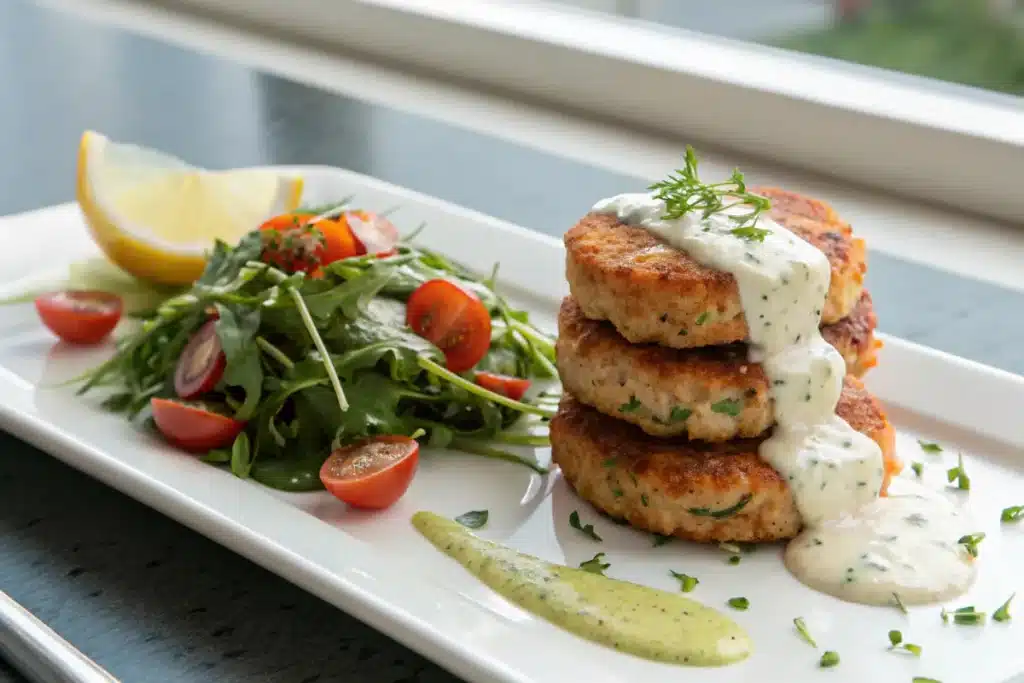
Salmon Cake Recipe Troubleshooting Guide
Problem: Cakes Falling Apart
Solutions for perfect binding:
- Add 1 extra egg yolk (rich in lecithin for cohesion)
- Chill mixture up to 2 hours (helps proteins set firmly)
- Use finer breadcrumbs (panko pulsed in blender works best)
Problem: Salmon Cakes Too Dry
Moisture-restoring fixes:
- Increase mayo to ⅓ cup (or substitute Greek yogurt)
- Mix in 2 tbsp sour cream or cilantro-lime crema from our taco bowls
- Reduce cooking time by 20% (check at 6 mins instead of 8)
Storage & Reheating
(Keep your salmon cake recipe tasting fresh-made with these pro techniques)
Refrigeration
- Best for: Short-term storage (up to 3 days)
- Method:
- Cool cooked cakes to room temp (≤1 hour for food safety)
- Place in airtight container with:
- Parchment between layers
- Damp paper towel on top to prevent drying
- Pro Tip: For extra moisture, brush patties with olive oil before refrigerating
Freezing
- Best candidates: Uncooked patties (cooked cakes lose crispiness)
- Freezer Prep:
- Arrange chilled patties on parchment-lined tray
- Flash-freeze 1 hour (prevents sticking)
- Transfer to:
- Vacuum-sealed bags (best)
- Freezer containers with wax paper dividers
- Thawing Options:
- Cook from frozen (add 5-7 mins to cook time)
- Overnight fridge thaw for more even heating
Reheating Methods Compared
| Method | Time | Key Technique | Best For |
|---|---|---|---|
| Oven | 10-12 min | Place on wire rack for air circulation | Restoring crispiness |
| Air Fryer | 5-7 min | Spray with oil, shake basket halfway | Quick single servings |
| Skillet | 3-4 min/side | Cover first 2 minutes to steam-center | Emergency meals |
Critical Note: Always reheat to 165°F internal temp (use a food thermometer).
Reviving Leftovers Like a Chef
- Crispness Boost:
- Spritz with water before oven reheating
- Finish under broiler 30 seconds
- Flavor Refresh:
- Squeeze fresh lemon post-reheating
- Top with quick dill-yogurt sauce (mix 1:1 ratio)
Salmon Cake Recipe FAQs
Q: Can I substitute canned tuna for salmon in this recipe?
A: Yes! Tuna cakes work well with this method—just drain the tuna thoroughly and adjust seasonings to taste. The texture will be slightly denser but equally delicious.
Q: What’s the secret to keeping salmon cakes from falling apart?
A: Three key tips:
- Chill the mixture for at least 30 minutes before cooking.
- Use enough binder (egg + mayo or Greek yogurt).
- Avoid overmixing—gently fold ingredients just until combined.
Q: Can I bake these instead of frying for a healthier option?
A: Absolutely! Bake at 400°F (200°C) for 15-20 minutes, flipping halfway, until golden. For extra crispiness, lightly spray with oil before baking.
Q: Are salmon cakes gluten-free friendly?
A: Yes! Simply swap regular breadcrumbs for gluten-free Panko, almond flour, or crushed gluten-free crackers. Ensure all other ingredients (like mayo and mustard) are certified gluten-free.
Q: How can I add more vegetables to this recipe?
A: Finely diced bell peppers, zucchini, or spinach blend seamlessly into the mixture. Just sauté them first to remove excess moisture.
Q: What’s the best way to reheat salmon cakes without drying them out?
A: For best results:
- Oven: 350°F (175°C) for 10-12 minutes
- Air Fryer: 375°F (190°C) for 5-7 minutes
- Skillet: Low-medium heat with a splash of oil
Q: Can I make these ahead of time for meal prep?
A: Yes! Prepare and shape the patties, then:
- Refrigerate (up to 24 hours) before cooking.
- Freeze uncooked (up to 3 months)—cook straight from frozen, adding a few extra minutes.
Q: What sides pair best with salmon cakes?
A: Try:
Creamy dips (tzatziki or avocado lime crema)
Light salads (citrus kale or cucumber-dill)
Roasted veggies (asparagus or sweet potatoes)
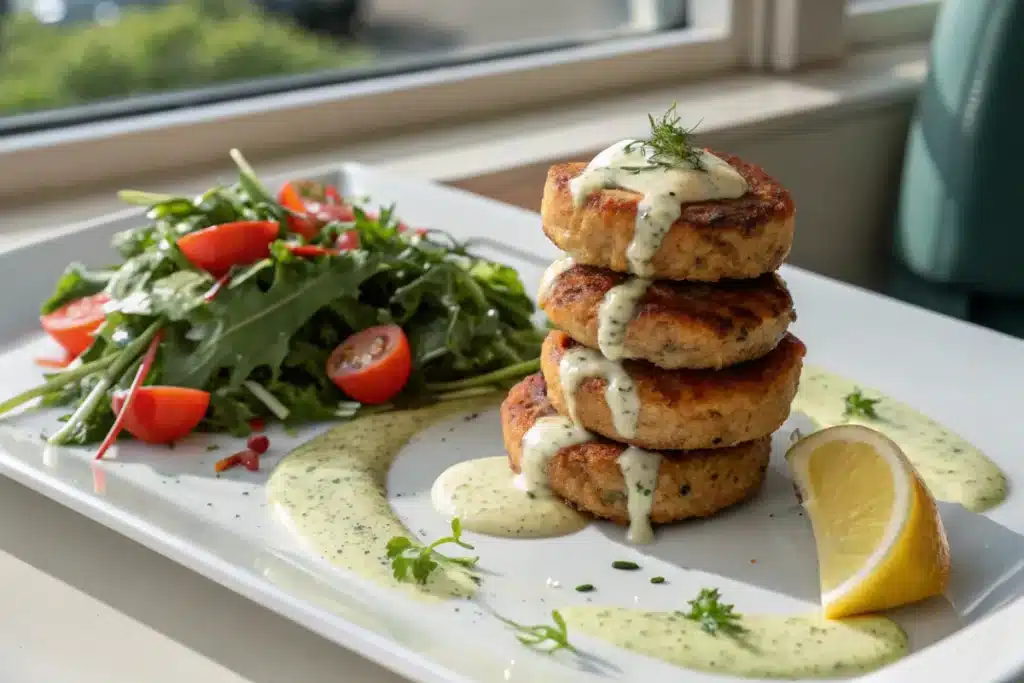
Chef’s Secrets: Pro Tips for Perfect Salmon Cakes Every Time
Take your salmon patties to the next level with these expert recommendations:
- Invest in a Quality Fish Spatula
- The thin, flexible edge slides effortlessly under delicate salmon cakes without breaking them
- Stainless steel with a slotted design allows excess oil to drain
- Look for one with an angled head for better control when flipping
- Make Double Batches for Meal Prep
- Salmon cakes freeze exceptionally well for up to 3 months
- Freeze individual patties on a parchment-lined sheet before transferring to airtight containers
- Reheat straight from frozen in a 375°F oven for 15-18 minutes
- Get Creative with Dipping Sauces
- Mango-habanero aioli: Blend ½ cup mayo with ¼ cup mango puree + 1 tsp habanero hot sauce
- Lemon-caper remoulade: Mix Greek yogurt with lemon zest, chopped capers, and dill
- Smoky chipotle lime: Combine sour cream with adobo sauce and lime juice
- Presentation Matters
- Serve on a bed of massaged kale or arugula for color contrast
- Garnish with microgreens and lemon wedges for restaurant-worthy plating
- Drizzle sauces in artistic patterns using a squeeze bottle
- Temperature Control is Key
- For pan-frying, maintain oil at 350-375°F for optimal crispiness
- Use an infrared thermometer for precise temperature monitoring
- Let cooked cakes rest 2 minutes on a wire rack to preserve texture
Now that you’ve mastered these techniques, try pairing your salmon cakes with our 4-ingredient banana bread for a complete meal. Share your creations below!

Salmon Cake Recipe
- Total Time: 20 minutes
- Yield: 6–8 salmon cakes 1x
- Diet: Gluten Free
Description
These golden-brown salmon cakes are packed with flavor and texture, making them an ideal appetizer or main course. Made with flaky salmon, fresh herbs, and a touch of zest, they’re pan-fried to perfection and served with a creamy dipping sauce. Quick to prepare and utterly delicious, these salmon cakes are sure to impress.
Ingredients
-
For the Salmon Cakes:
- 1 pound cooked salmon, flaked (canned or fresh)
- 1 cup panko breadcrumbs, divided
- ¼ cup finely chopped red onion
- 2 tablespoons finely chopped fresh parsley
- 1 tablespoon fresh lemon juice
- 1 teaspoon lemon zest
- 1 large egg, lightly beaten
- 1 teaspoon Dijon mustard
- Salt and freshly ground black pepper, to taste
- 3 tablespoons olive oil (for frying)
-
For the Creamy Dipping Sauce:
- ½ cup sour cream or Greek yogurt
- 1 tablespoon fresh lemon juice
- 1 teaspoon lemon zest
- 1 teaspoon Dijon mustard
- 1 teaspoon honey or maple syrup
- Salt and freshly ground black pepper, to taste
Instructions
-
Prepare the Salmon Mixture:
- In a large mixing bowl, combine the flaked salmon, ½ cup of panko breadcrumbs, red onion, parsley, lemon juice, lemon zest, egg, Dijon mustard, salt, and pepper. Mix gently until all ingredients are evenly incorporated.
- Form the mixture into 6–8 patties, about ½-inch thick. Coat each patty evenly with the remaining panko breadcrumbs, pressing gently to adhere.
-
Make the Dipping Sauce:
- In a small bowl, whisk together the sour cream (or Greek yogurt), lemon juice, lemon zest, Dijon mustard, honey (or maple syrup), salt, and pepper. Taste and adjust seasoning as needed. Set aside.
-
Cook the Salmon Cakes:
- Heat olive oil in a large skillet over medium heat. Once the oil is shimmering, add the salmon cakes in batches, being careful not to overcrowd the pan.
- Cook for 3–4 minutes per side, or until golden brown and crispy. Transfer the cooked cakes to a plate lined with paper towels to drain excess oil.
-
Serve:
- Arrange the salmon cakes on a serving platter and garnish with additional parsley or lemon wedges if desired. Serve warm with the creamy dipping sauce on the side.
Notes
- These salmon cakes are versatile and can be served as an appetizer, main course, or even in a sandwich with a dollop of the creamy dipping sauce.
- Fresh herbs like dill or chives can be substituted for parsley if preferred.
- For a gluten-free version, use gluten-free breadcrumbs and ensure all other ingredients (like mustard) are certified gluten-free.
- Prep Time: 15 minutes
- Cook Time: 10 minutes
- Category: Snacks
- Method: Pan-Frying
- Cuisine: American
Nutrition
- Serving Size: 1 salmon cake + 2 tablespoons dipping sauce
- Calories: 280 kcal
- Sugar: 3g
- Sodium: 350 mg
- Fat: 15g
- Saturated Fat: 3g
- Unsaturated Fat: 9g
- Trans Fat: 0g
- Carbohydrates: 14g
- Fiber: 1g
- Protein: 20g
- Cholesterol: 75 mg

